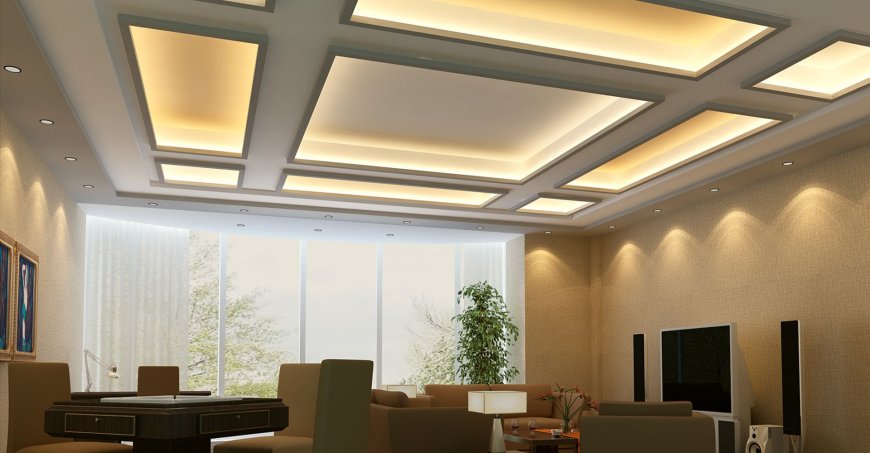Is Gypsum Board Ceiling Safe? Fire, Moisture, and Durability Explained
Wondering if gypsum board ceilings are safe? Learn about their fire resistance, moisture protection, and durability in this expert guide.

Introduction
Homeowners and contractors often turn to gypsum board suppliers in Dubai for reliable, modern ceiling solutions. As gypsum board ceilings grow in popularity across residential and commercial projects, safety becomes a primary concern. Are they truly fire-resistant? Can they withstand moisture and humidity? How long do they last?
This comprehensive guide will walk you through the core safety aspects of gypsum board ceilingsincluding fire performance, water resistance, and long-term durabilityso you can make an informed and confident decision for your space.
1. Understanding the Composition of Gypsum Boards
Gypsum boards, also known as drywall or plasterboard, are made from a non-combustible core of gypsuma naturally occurring mineral. This core is sandwiched between two layers of durable paper or fiberglass mats. The result is a sturdy, lightweight panel used widely for ceilings and walls.
Gypsum is special because of its water content that is chemically bonded. When exposed to heat, this water turns into steam and acts as a protective barrier, making gypsum boards especially effective in fire-prone zones.
2. Fire Resistance: Built-In Protection Against Flames
A. Natural Fire Resistance
Gypsum board ceilings are inherently fire-resistant. The crystalline structure of gypsum contains up to 21% water by weight. When heated, this water is released as steam, helping to delay the spread of flames. This makes gypsum boards ideal for both residential and commercial buildings, particularly in kitchens, corridors, or high-risk areas.
B. Fire-Rated Gypsum Boards
Special fire-rated gypsum boards are employed in crucial areas.These include added fibers and additives to improve thermal resistance. When properly installed with supporting materials like steel framing or mineral wool, these boards can provide up to 2 hours of fire protection.
C. Compliance with Building Codes
Many building regulations require the use of fire-rated ceiling materials. Gypsum boards usually meet or exceed international fire safety standards, offering peace of mind to property owners and contractors alike.
3. Moisture and Humidity Resistance: Safe for Wet Areas?
A. The Problem with Standard Gypsum in Wet Zones
Standard gypsum boards are not naturally waterproof. Without proper protection, prolonged exposure to water can weaken the board, cause it to sag, or lead to mold and mildew.
B. Moisture-Resistant (MR) Gypsum Boards
Thankfully, many gypsum board suppliers in Dubai offer moisture-resistant variants, which include a treated core and water-repellent surface layers. These are perfect for high-humidity areas such as:
-
Bathrooms
-
Kitchens
-
Laundry rooms
-
Basements
C. Mold-Resistance and Hygiene
Moisture-resistant gypsum boards often include antifungal additives, which help prevent black mold and other harmful bacteria. This ensures a more hygienic indoor environment, particularly important in homes with children, elderly residents, or allergy sufferers.
4. Durability: How Long Do Gypsum Board Ceilings Last?
A. Structural Longevity
When installed correctly and kept dry, gypsum board ceilings can last 2030 years or more without significant damage. They resist cracking, bending, and impact under normal use.
B. Surface Resilience
Gypsum boards maintain their appearance well over time. Unlike traditional plaster, they are less prone to shrinkage or discoloration. Repainting the surface every few years is usually enough to keep the ceiling looking fresh.
C. Resistance to Insects and Pests
Gypsum does not attract termites or rodents, making it a safer and cleaner option compared to wood-based ceilings. Additionally, it does not emit harmful chemicals or odors, supporting better indoor air quality.
5. Safety During Installation
Gypsum board ceiling installation is generally safe when handled by professionals. The material is non-toxic, non-asbestos, and poses no risk when cut, drilled, or mounted. However, during installation, safety protocols such as dust masks and eye protection should still be followed, especially when sawing or sanding the boards.
6. Environmental and Health Safety
Environmentally friendly gypsum boards are frequently made from recycled resources.They emit low or zero VOCs (volatile organic compounds), which improves indoor air quality. This makes them suitable for:
-
Residential homes
-
Healthcare facilities
-
Schools and offices
-
Commercial spaces
Additionally, the boards are fully recyclable, aligning with green building practices and sustainability certifications.
7. Regular Maintenance Tips to Ensure Safety
Although gypsum ceilings require minimal upkeep, a few simple habits can enhance their longevity and safety:
-
Avoid leaks from plumbing or roofs to prevent moisture damage.
-
Repaint surfaces every 35 years to maintain a fresh look.
-
Inspect joints and screws occasionally to avoid sagging.
-
In high humidity areas, ensure proper ventilation and exhaust fans.
Conclusion
In summary, gypsum board ceilings offer a safe, durable, and aesthetically pleasing solution for modern interiors. With built-in fire resistance, availability of moisture-proof options, and a lifespan that spans decades, they are a smart investment for both safety and style.
When sourced from trusted gypsum board suppliers in Dubai, you can expect quality materials that meet global safety standards. Whether you're renovating your home or constructing a commercial space, gypsum board ceilings stand out as a safe, long-lasting option that blends performance with elegance.


















